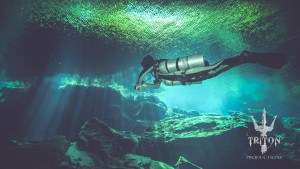Cenote Kukulkan hides many treasures: Aragonite crystals are secreted like little gems in a jewel box.
His large open water area will give you time to enjoy the extraordinary visibility and sunlight beams. For beginner divers, it gives you time to adjust your buoyancy and skills in shallow freshwater. Advanced divers can enjoy the unique light show.
After a few minutes, you dive down under the halocline. The halocline is the layer between the saltwater filtering through the rock from the ocean and the fresh water on top. These two layers have different densities, salinities, temperatures, and visibilities. In Cenote Kukulkan, the saltwater layer is warmer, almost one more degree, denser, saltier, and has more reduced visibility.

During the last few years, we have also observed a sulfide layer just under the halocline. This had a creepy atmosphere and clearly contrasts with the beautiful crystal clear blue freshwater. The origin of this layer is still unknown. It most likely results from anthropic activity altering the ecosystem… This passage in the sulfur layer is concise, just enough to make you appreciate the contrast and the light curtain once you cross the halocline again.

Diving in cenote Kuukulkan at a glance
- Certification needed: OW Diver
- Difficulty: Easy
- Entry fee: 250$ Pesos
- Access to the water: short walk from the parking lot and Stone steps to both Little Brother and Chac Mool
- Max depth: 15m/50ft
- Infrastructure: Bathroom – Changing room – Snack bar
- Combine with: Chac Mool
- Features: light, fossils, halocline, stalactites
